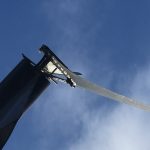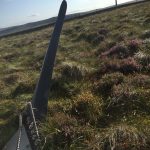Over the years I lot of people have phoned me with tales of woe about small wind turbines. I am sympathetic of course, because I know how it feels first hand but I have become hardened over the years. I do it because I love it and I know that it will hurt at times but for me it’s worth it. What saddens me is that most people are shocked and disappointed by wind turbine failures whereas those of us who work in the small wind industry are mostly well aware and have seen plenty go wrong.
I’d like to try to redress the balance of the sales hype a little by sharing a couple of photos I received from Fiona, a UK wind turbine owner the other day. This turbine is only four years old and has had plenty of repairs done already. It’s on a good site, and generates £2600 worth of feed in tariffs per year, but servicing is expensive. Lately Fiona has fallen out with the company that installed the system. The installer insists on charging for replacement parts even though the manufacturer has accepted that they are warranty replacements.
It’s tough on all concerned when a machine keeps going wrong, but it’s not a complete surprise to those of us who know small wind turbines. Some work well but others (especially on high wind sites) are complete troublemakers. My advice has always been “Don’t buy a small wind turbine to save money. Do it for love, and enjoy the unique feeling but don’t expect an easy ride.”
- one blade missing
- landed 150 metres away
- the theory of how it works
It’s great to see wind turbines sited well away from public areas rather than on rooftops(!!) and close to school front doors. But if this blade had flown the same distance in the opposite direction it could just have smashed a window and entered the house. Personally I see this as a justifiable risk. It’s about as likely as being struck by lightning or blown up by a terrorist so not worth losing sleep over but wind turbine buyers need to be aware of it and that’s the reason for my post. Also to say that events like these can severely test your relationship with your installer, even though it is none of your making.





Thanks Huge for your innovative idea. I found your blog impressive and helpful as well.
Sorry…I needed to edit a sentence but was unable to get back to it.
I find reports, such as this one, quite distressing. I suppose that having a central registry to record events, like this one, for public consultation, would open up a can of worms in terms of potential lawsuits. Manufacturers could be asked for permission to record the performance of their products though.
To me, it’s a matter of design and quality of materials. Why is it that some old-time wind turbines, although not perfect, managed to hang together while a good number of today’s small turbines seem to have difficulty ? It’s almost as though nobody has learned from the past. For example, jacobs Wind Electric -again, not perfect- managed great reliability even in high wind speed areas.
If very high wind speeds are a contributing factor, why not include a shut-down mechanism for when the wind exceeds 100kph, or something similar ?
I don’t know what regulations Europeans are struggling with but, given the posts on this blog, I’ve concluded that many turbines, both in France and the UK, seem to be on fairly low towers…there’s no doubt that this would introduce some factors that place a lot of stress on turbines, particularly wind shear and increased turbulence, that can be particularly hard on downwinders (like the one pictured here) as well as on two bladed turbines. Perhaps you can clarify this, Hugh.
With her revenue of 2,600 pounds/year, this lady must live in a very windy spot It’s a shame that inadequacies in the machine design and/or materials selection seems to be working against her.
Dave
hi David,
I have seen turbines of this “Proven” type run for years with scarcely any maintenance, through record breaking storms. (Others suffer lots of problems.) This is a very high wind site but the principle of a turbine that runs through all conditions is perfectly viable. In my opinion there are details of the construction of this turbine (likely related to spring characteristics) that are at the root of the problem. The design has been modified a few times over the years.
I learned today that it actually produces £2,900 worth of feed in tariffs, and not £2,600. Also I need to point out that it is a 3-blade design and very smooth running when properly implemented.
The issue here is the validity of the warranty offered by the manufacturer and installer. Will they stand by their warranty when it comes to the crunch?
Hugh
Right ! I’ve read your posts re. the Proven and it’s good to hear about its reliability.
What can I say ? A warranty issue…perhaps even more important is that, for a reputable manufacturer, it represents what may be an uncommon opportunity to hone its product even more and to make it even better.
Sounds like the installer is the fly in the proverbial ointment. Why doesn’t everyone work together to take advantage of the opportunity at hand? it’s not a matter of confrontation, foot dragging and petty opportunism; that won’t get anyone further ahead.
I’ve been told about better small wind turbines in which the blade is inside a metal drum, with flaps to direct the wind through the drum, turning the turbine. This design is better at moderating the wind flow and shifting direction to keep a constant flow of wind, when there is any, through the turbine. The blades can’t go anywhere, as they’d hit the inside of the drum.
Hi
Yes that’s all very well but the wind doesn’t really like being put in a box and so although such ideas have always been around they have never proved successful.
We’d all like to be perfectly safe but the reality is that every activity and process contains an element of risk. In the sort of weather when wind turbine blades fly around there is a much higher likelihood that you will be hit by a slate off a roof or some other random piece of flying debris. I don’t wish to create undue anxiety, but on the other hand I do think some wind turbines are sited with scant regard for safety. Parts flying off is by no means a rare occurrence. This was an extreme example!
Hugh